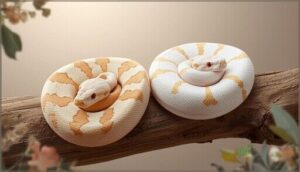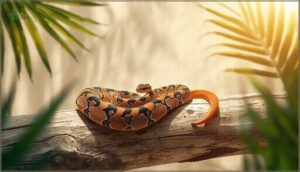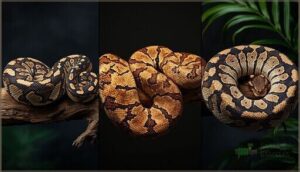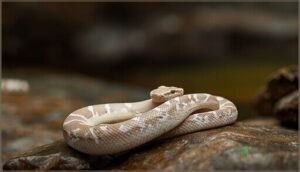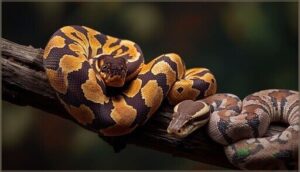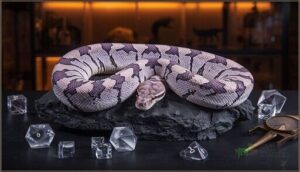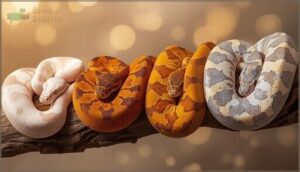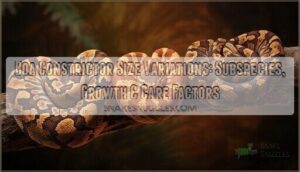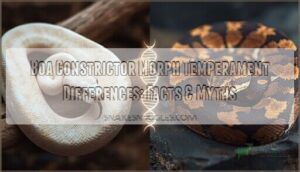This site is supported by our readers. We may earn a commission, at no cost to you, if you purchase through links.
The python ball python hobby exploded with designer morphs decades ago, but boa constrictor morphs and genetics have quietly built their own stunning revolution. Walk into any reptile expo today and you’ll find boas displaying colors and patterns that would have seemed impossible thirty years ago—ghostly white albinos, jet-black IMG specimens that darken with age, and leopard-spotted beauties that break every rule of typical boa patterning.
Unlike ball pythons with their single-gene simplicity, boa genetics operate through a fascinating mix of dominant, recessive, and polygenic traits that create exponentially more possibilities. Understanding how these genes interact doesn’t just help you predict what babies might hatch from a breeding pair. It opens up a world where you can architect living art, combining multiple mutations into snakes that push the boundaries of what’s possible while maintaining the sturdy health and temperament that make boas such rewarding captives.
Table Of Contents
- Key Takeaways
- What Are Boa Constrictor Morphs?
- Basic Genetics: Understanding Boa Inheritance Patterns
- Popular Boa Constrictor Morph Types
- Dominant and Codominant Boa Morphs
- Recessive Boa Morphs and Breeding Strategies
- Designer Morphs and Genetic Combinations
- Ethical Breeding Practices and Genetic Health
- Selecting and Purchasing Boa Morphs
- Essential Care for Boa Morphs
- Frequently Asked Questions (FAQs)
- Conclusion
Key Takeaways
- Boa constrictor morphs result from selective breeding of genetic mutations affecting color and pattern, operating through dominant, recessive, and polygenic inheritance patterns that create exponentially more breeding possibilities than ball python genetics.
- Understanding genotype versus phenotype is critical for predicting breeding outcomes—recessive traits like Albino and Leopard require two gene copies to express visually, while dominant traits like IMG and Arabesque show up with just one copy.
- Designer morphs combine multiple genetic traits (such as Sharp Snow blending Albino and Anery, or Eclipse mixing Leopard with Motley) to create unique visual effects that command premium prices but require careful planning across multiple generations.
- Ethical breeding practices prioritize genetic diversity through strategic outcrossing and health screening to avoid defects like neurological issues in Super Aztec morphs or the lethal outcomes seen in Super Motley pairings.
What Are Boa Constrictor Morphs?
Boa constrictor morphs are captive-bred variations that look dramatically different from their wild counterparts. These unique color and pattern combinations result from selective breeding that highlights specific genetic traits.
To understand what makes a morph special, you’ll need to know how they differ from natural boas, what selective breeding actually does, and why morphs aren’t just wild variations with fancy names.
Defining Morphs Vs. Natural Locality Variations
When you’re exploring boa constrictor morphs, you’re looking at captive-bred genetic variants with unique color and pattern traits—not just wild populations with natural locality variations. Morphs result from specific mutations affecting pigmentation genes, engineered through selective breeding. Locality variations, by contrast, reflect evolutionary adaptations shaped by environment and geography.
The Boa genus includes three known species, including the popular Boa constrictor. Understanding genotype versus phenotype helps you recognize these breeding implications and avoid recognition challenges when evaluating visual appearance.
The Role of Selective Breeding
Selective breeding drives morph trait selection by pairing boas with desirable genes—think line breeding to lock in vibrant colors or specific patterns. You’re practically stacking the genetic deck.
However, breeding strategies must balance aesthetic goals with genetic diversity to avoid inbreeding consequences like reduced fertility or health defects. Ethical breeding prioritizes healthy animals over flashy designer morphs, ensuring breeding outcomes benefit both the snakes and the hobby long-term.
Ethical breeding balances aesthetic goals with genetic diversity, prioritizing healthy animals over flashy designer morphs to benefit both snakes and the hobby long-term
Boa constrictors have hundreds of unique morphs due to genetic mutations.
How Morphs Differ From Wild-Type Boas
Wild-type boas showcase brown or gray base coloration with reddish saddles, while morphs drastically alter phenotype through genetic variation—albinos lose melanin entirely, displaying white bodies and red eyes. Pattern deviations range from motley’s circular markings to leopard’s blotchy spots.
Size variance matters too; Colombian wild-types hit 12 feet, but Blood boa morphs max out around 5 feet. Growth rates and temperament shifts also distinguish morphs from their wild-type ancestors.
Basic Genetics: Understanding Boa Inheritance Patterns
Before you start pairing boas to create your dream morph, you need to understand how genes actually work. The good news is that boa genetics follow predictable patterns—once you grasp a few key concepts, you’ll be able to forecast what traits your snakes will pass on.
Let’s break down the fundamental inheritance patterns that determine whether you’ll hatch out albinos, anerys, or something completely unexpected.
Genotype Vs. Phenotype Explained
Think of genotype as the blueprint hidden in your boa’s DNA, while phenotype is what you actually see. Understanding genetics starts here—phenotype describes your snake’s visible traits, but genotype reveals the complete genetic story:
- Genotype consists of two alleles at each gene location
- Heterozygous (Aa) carries one wild-type and one mutant allele
- Homozygous recessive (aa) expresses traits like albino
- Phenotype Variation shows physical appearance despite hidden genes
- Environmental Influence can subtly affect how genes express visually
This distinction drives every breeding decision you’ll make.
Dominant Trait Expression
When you’re working with dominant traits, your boa shows the trait even with just one copy of the gene—that’s heterozygous expression in action. A single dominant allele changes what you see, making visual identification straightforward and breeding ratios predictable.
| Cross Type | Visual Offspring | Hidden Carriers | Viability Concerns |
|---|---|---|---|
| Het × Wild | 50% dominant | 50% wild-type | Generally hardy |
| Het × Het | 75% dominant | 25% wild-type | Watch for lethal combos |
| Hypo × Albino | 100% Hypo Het Albino | All carry recessive | Healthy morph interactions |
| IMG × IMG | 100% darker boas | Homozygous possible | Progressive melanin increase |
Dominant gene inheritance lets you stack traits like IMG with albino, creating stunning designer combos where one dominant trait visibly layers over recessive genetics.
Recessive Trait Expression
When your boa carries two copies of a recessive gene—homozygous recessives like Albino or Leopard—you’ll see the visual trait. Heterozygous carriers look normal but pass the recessive allele to half their offspring.
Mendelian probabilities guide breeding programs: het × het pairings yield 25% visual morphs, while trait combinations like Snow boas need both Albino and Anery recessive genes expressed simultaneously.
Incomplete Dominance in Boa Morphs
Between wild-type and homozygous “super” forms, an exciting middle ground exists—incomplete dominance. Your heterozygous Motley or Hypo shows a blended phenotype distinct from both parents, creating three visual classes instead of two.
Mendelian ratios predict 25% normals, 50% single-gene morphs, and 25% supers when breeding het × het. Combo morphs stack these traits beautifully, though viability concerns arise with certain super forms like super Motley.
Polygenic Traits and Multiple Gene Interactions
Not every trait in your boa follows simple Mendelian rules—some, like subtle color shifts or body size, stem from polygenic inheritance where multiple genes work in concert. Quantitative genetics reveals these patterns through heritability estimation and trait covariance studies.
Key concepts include:
- Epistasis effects modify how genes interact
- Color polymorphism arises from many loci
- Inheritance patterns become probabilistic, not binary
- Gene expression varies continuously
- Traits show additive genetic variance
Understanding these interactions helps predict offspring outcomes beyond single-gene morphs.
Popular Boa Constrictor Morph Types
Now that you understand how boa genetics work, let’s look at the morphs themselves.
The boa breeding world has produced some genuinely stunning variations, each with its own genetic signature and visual appeal.
Here are the most popular morphs you’ll encounter as you explore this exciting corner of reptile keeping.
Albino Morphs (T+ and T-)
Albino boas showcase one of the most striking examples of recessive traits in boa constrictor morph genetics. They completely lack melanin synthesis, resulting in vividly yellow and white bodies paired with red eyes.
The two main lines, T+ vs T−, differ in pigmentation intensity. T+ Albinos retain partial tyrosinase function, displaying warmer cream tones, while T− animals show purer whites.
Both lines have flooded the Albino market, with over 900 listings in 2024 alone. They are essential building blocks for Snow combinations (Albino plus Anery) and Sunglow variations (Albino plus Hypo), making them invaluable in breeding projects.
Anerythristic (Anery) Morphs
Imagine a boa stripped of all red pigment—that’s Anerythristic genetics at work. Anery boas hatch with silver bodies and lavender tails that shift to brown over time, making them a popular grayscale option in boa constrictor morphs.
As a recessive trait, breeding Snows requires pairing Anery with Albino to enable visual combinations like Ghost (Anery plus Hypo) that define modern boa constrictor morph genetics.
Hypomelanistic (Hypo) Morphs
If you want cleaner color and brighter saddles, Hypomelanistic Boa genetics deliver. Hypo Boas strip out black and brown pigment, creating animals with vivid backgrounds—codominant inheritance means even one Hypo gene makes a visible difference in Boa constrictor morphs.
- Salmon Hypo breeders select for enhanced orange intensity and contrast
- Orangetail Hypo lines emphasize vivid tail coloration
- Hypo combinations like Ghost and Sunglow stack color-intensifying effects across multiple genes
Hypo identification relies on reduced melanin and increased saturation in Boa color variations.
Motley and Pattern Mutations
Pattern inheritance transforms Boa pattern genetics in bold ways. Motley Boa mutations—imported in 1994—disrupt saddles into aberrant patterns. Super Motley offspring appear when you breed two Motleys, intensifying combination effects.
Jungle Pattern and Stripe Pattern add codominant twists, while pattern disruptions range from subtle to dramatic.
Pattern rarity drives value, especially when stacked with Albino or Hypo genes for high-contrast designer animals.
IMG and Melanin-Enhancing Morphs
IMG Boa genetics enable dramatic melanin accumulation over time. Hatchlings resemble wild-type Boa constrictor morphs, then darken progressively as melanin production intensifies—some adults turn nearly black.
This darkening process makes IMG inheritance (incompletely dominant) a favorite for combo potential with Albino, Motley, and Aztec lines.
Future trends point toward extreme contrast animals, with IMG dominating high-end breeding projects focused on skin pigment enhancement.
Leopard, Aztec, and Aberrant Pattern Morphs
If you’re drawn to broken-up, irregular pattern disruptions, Leopard and Aztec Boa constrictor morphs offer combination potential that most breeders can’t resist.
Leopard—a recessive trait first bred from Sonoran Desert stock in Germany—produces smaller adults around five feet, while Aztec (codominant) delivers aberrant variations with fragmented saddles.
Pattern inheritance in both lines has driven future trends in morph identification, making aberrant Boa constrictor appearance a breeding staple today.
Sterling and Patternless Morphs
Sterling boas represent the opposite end of the pattern spectrum—no saddles, no chaos, just clean earth tones. These patternless genetics create a smooth canvas that some breeders love and others find too understated.
Understanding the genetics behind reduced patterns reveals breeding challenges: Sterling behaves as a recessive trait, so producing visual animals demands careful genotype planning.
The visual appeal lies in simplicity, making Sterling a niche favorite among Boa constrictor morphs that value minimalism over complexity.
Dominant and Codominant Boa Morphs
Dominant and codominant morphs give you visible results with just one copy of the gene, making them incredibly efficient for breeding projects. Unlike recessive traits that hide in carriers, these genetics show up immediately in your offspring.
Let’s look at the key dominant morphs that can transform your breeding program from the first generation.
Arabesque Morphs
When Steve Hammond introduced the Arabesque boa in 1989, he changed boa constrictor genetics forever. This dominant morph displays stunning pattern variations—hyper-melanistic traits create intense black speckling across a cocoa-colored canvas. You’ll notice homozygous effects heighten this drama even further.
Breeding combos with albino or hypo morphs create incredible designer possibilities, which explains their strong market value among collectors seeking something truly distinctive.
IMG (Azabache) and Scoria
When Peter Kahl proved the IMG inheritance pattern in 2007, he revealed one of boa constrictor genetics’ most fascinating traits. These Colombian specimens—originally called “Azabache”—darken progressively as melanin development intensifies over five years.
Understanding boa genetics means recognizing IMG’s codominant nature, which delivers 50% visual offspring. Meanwhile, Scoria wobble complications mirror spider ball python issues, making combination outcomes with IMG unpredictable yet valuable in market valuation discussions.
Inca Morphs
Nicaraguan Inca boas showcase dominant genetics through their signature connected “chainlink” saddle patterns, a locality influence refined through selective breeding. Unlike morphs with super forms, Inca genetics produce consistent pattern variations whether heterozygous or homozygous.
You’ll find these compact 4-5 foot specimens commanding $700-$900 at expos, though breeding strategies focus less on producing doubles and more on pairing Inca with color mutations for designer combinations that increase market value.
How Dominant Genes Affect Breeding Outcomes
Dominant genes accelerate your morph collection because heterozygous pairings yield 50% visual offspring right away—no “possible het” guesswork needed. When you breed two dominant carriers together, homozygous effects may appear in 25% of the clutch, though many boa dominant traits don’t show distinct super forms.
These visual enhancers also shine in combos, masking traits like albino backgrounds while delivering faster establishment of designer lines than recessive projects ever could.
Recessive Boa Morphs and Breeding Strategies
Recessive morphs are the hidden gems of boa genetics—they only show up when both parents pass down the same gene. Breeding for these traits requires patience and strategy, since you’ll need to work with carriers and plan several generations ahead.
Let’s break down the key recessive morphs and the breeding techniques that’ll help you realize their potential.
Blood Boa Genetics
Blood boas are classic recessive gems from El Salvador, reaching only five feet and packing an intense red color that darkens as they mature. You’ll need two copies of the Blood gene to see that signature crimson phenotype expression.
When paired with hypo or albino traits in designer projects, Blood becomes a red enhancer worth $500–$750+, making it a staple in boa constrictor morph genetics.
Leopard and Sterling Genetics
Leopard inheritance follows recessive rules too—you’ll need two copies for that jet-black eye and connected saddle pattern. Visual hets are your shortcut here, unlike Sterling appearance, where carriers hide completely.
Sterling genetics create pattern reduction that’s almost metallic-bright, ideal for designer combos. Understanding genetics means you’ll predict breeding statistics better: Leopard litters average 4–9 offspring, while Sterling demands homozygous pairings to shine.
Breeding for Recessive Traits
Pairing two hets gives you 25% visual offspring—the recessive traits finally show up. Triple heterozygous pairings drop odds to 12.5%, making double recessive trait breeding complex but rewarding.
You’re juggling inbreeding risks here, so genetic calculators help predict morph viability before you commit. Recessive gene inheritance demands patience—most litters hide carriers you won’t see until F2 generations reveal what’s lurking in their genotype.
Using Punnett Squares to Predict Outcomes
Punnett Squares map out genetic outcomes before you even pair your boas. A het albino x het albino cross predicts 25% visual albino offspring, 50% het carriers, and 25% normal—that’s your inheritance patterns laid bare.
You’ll verify breeding results by tracking dominant, recessive, and polygenic traits across litters. Het probabilities shift with each pairing: recessive predictions differ wildly from dominant inheritance scenarios, especially in combo morphs where multiple genes interact.
Designer Morphs and Genetic Combinations
Designer morphs are where boa breeding gets really exciting—you’re combining multiple genetic traits to create something completely new. These combos can intensify colors, blend patterns, or produce visual effects that single-gene morphs just can’t achieve.
Let’s look at some standout combinations that showcase what’s possible when you mix the right genetics.
Fire Boa as a Genetic Enhancer
Think of Fire as the secret ingredient that makes everything pop. This incomplete dominant gene lightens coloration and adds visual appeal to any designer projects it touches.
The homozygous Super Fire produces stunning leucistic white boas with black eyes—one of the rarest availability morphs you’ll find. Fire compatibility with morphs like Jungle and Scoria demonstrates how selective breeding shapes boa constrictor morphs through strategic genetic inheritance.
Eclipse (Leopard + Colombian Motley)
When you cross the recessive Leopard gene with the incomplete dominant Colombian Motley, you’ll produce the Eclipse—a striking boa constrictor morph first achieved by Blumen Boas in 2012. This combination creates a mostly black or grainy appearance with clear color contours from the Motley influence and high-contrast mottling from Leopard genetics.
Breeding outcomes demonstrate how understanding genotype and phenotype predictions helps you create these designer color morphs.
Sharp Snow and Multi-Gene Combos
Sharp Snow represents one of the most sought-after double recessive morphs, blending Sharp Albino (T-) and Anerythristic genetics to produce pale yellow and gray boas with reduced black pigmentation.
You can expand this foundation through selective breeding with additional genetic mutations:
- Sharp Snow Glow adds Hypomelanistic for enhanced brightness
- Paradigm combinations integrate Boawoman Caramel or Prodigy Albino
- Designer morphs use genetic markers to predict breeding outcomes
Creating Unique Visual Combinations
When you stack multiple incomplete dominant enhancer genes—such as Hypo, Jungle, and albino—you’ll create designer boa morph combinations that command premium prices. Multi-gene stacking creates four distinct visual tiers in each clutch, with Fire color boost intensifying saturation and Motley pattern influence producing striped or band-reduced animals.
Selective breeding of boas using calculated breeding plan design transforms boa morph appearance factors, driving boa morph popularity across boa morph types.
Ethical Breeding Practices and Genetic Health
Breeding boa morphs isn’t just about creating stunning color combinations—it’s about maintaining healthy genetics for generations to come. The decisions you make as a breeder directly impact the long-term viability of your animals and the hobby as a whole.
Let’s explore the key practices that separate responsible breeding from shortcuts that can harm your snakes.
Line Breeding Vs. Outcrossing
You’ll face a pivotal fork in the road when breeding boas: line breeding refines specific traits by pairing relatives, boosting breeding success and predictability, but it amplifies inbreeding risks like recessive defects—think one-eyed albinos.
Outcrossing introduces fresh bloodlines, enhancing genetic diversity and fitness impact.
Ethical breeding means balancing both approaches, prioritizing health while achieving your vision for stunning, healthy morphs.
Maintaining Genetic Diversity
Want your boa morph collection to thrive for generations? Prioritize founder introduction and balanced breeding—don’t let a few popular sires dominate.
Effective population management and regular outcrossing strategies weave genetic diversity into every clutch, keeping inbreeding risks low.
Genetic monitoring helps spot bottlenecks early, so you can safeguard population health and keep your breeding program vibrant and resilient.
Avoiding Genetic Defects
Breeding boa morphs without understanding genetic defects is like playing genetic roulette—some combinations are lethal. Super Motley boas rarely survive past two years, while Super Aztec individuals show neurological wobble and infertility.
Smart outcrossing strategies help you sidestep inbreeding risks:
- Kahl and Sharp Albino lines produce bug eyes from early inbreeding
- Super Hypo morphs develop “blown tire” musculature defects
- Fire morphs occasionally show thin skin and undersized scales
- Genetic testing reveals inclusion body disease in 41.5% of tested populations
- Selective breeding post-testing preserves morph health while reducing birth defect rates
Responsible Morph Production
Understanding defects matters, but responsible morph production goes further. You’ll make ethical breeding decisions when you screen for genetic issues before pairing, document lineage transparently, and outcross every 1–2 generations to maintain genetic diversity.
Breeder transparency about known risks protects snake welfare—facilities using structured record-keeping show 15–20% higher heterozygosity, reducing inbreeding risks and supporting long-term morph health across your collection.
Selecting and Purchasing Boa Morphs
Once you understand boa genetics, the next step is finding the right morph and breeder for your collection. Smart purchasing decisions depend on evaluating breeders, pricing, lineage, and temperament before you commit.
Let’s break down what you need to know to make an informed choice.
Researching Reputable Breeders
How do you separate the serious pros from backyard hobbyists? Start by checking online reviews and marketplace ratings. Verify licensing verification where applicable, request genetic documentation of lineage, and assess breeder communication quality.
68% of European breeders conduct health screening for parasites, so don’t settle for less. Reputable breeders prioritize snake welfare, maintain genetic diversity through ethical breeding practices, and openly discuss morph health histories.
Understanding Morph Pricing Factors
Once you’ve found a trustworthy breeder, it’s time to understand morph pricing factors. Morph rarity drives costs—normal boas start around $50–$150, while complex designer combos can hit $2,200 or more. Market demand shifts prices over time, and boa age matters too: juveniles cost less than adults. Sales source and ethical costs also influence what you’ll pay.
- Morph Rarity: Multi-gene combos command premium prices
- Market Trends: Collector demand elevates designer morph values
- Boa Age and Sex: Adults and breeding females cost considerably more
- Sales Source: Professional breeders generally charge more than pet stores for documented lineage
Evaluating Genetic Lineage
Beyond price tags, you’ll want to examine genetic lineage carefully. Ask breeders about population structure and inheritance patterns—are you getting a documented bloodline or a mixed wildtype?
Genomic markers and evolutionary units aren’t just academic terms; they tell you about genetic diversity and health risks. Strong lineage identification helps you predict genetic traits, avoid inbreeding issues, and understand what you’re really bringing home.
Temperament Considerations Across Morphs
Temperament genetics can surprise you—while most boa morphs don’t show consistent temperament differences, lineage matters more than color genes. Colombian morph lines, bred across generations, generally offer beginner-friendly docility. Handling influence from hatch shapes adult behavior regardless of phenotype, but you should avoid problematic morphs like Scoria (potential wobble) or Super Motley pairings (often lethal).
When considering temperament, prioritize:
- Captive-bred Colombian morphs for consistently calmer baseline behavior
- Breeders with multi-generation handling records proving stable genotype outcomes
- Avoiding health-compromised combinations that complicate both welfare and handling
Essential Care for Boa Morphs
Once you’ve brought your boa morph home, the real work begins. Even the most stunning genetic combination won’t thrive without proper care that considers their physical needs.
Let’s walk through the essentials that’ll keep your boa healthy and comfortable for years to come.
Housing and Enclosure Requirements
Your boa’s home isn’t just a box—it’s where they’ll spend their entire life. Enclosure size must grow with your snake: babies need 2’x1.5′, while adults over 8 feet demand 8’x4′ minimum.
Pack substrate 4 inches deep for humidity retention, install secure hide placements on both warm and cool sides, and add climbing branches because even heavy-bodied boas love vertical space.
Security features prevent escapes.
Temperature and Humidity Control
Mastering environmental factors for boas means creating a thermal gradient from 75–80°F on the cool end to 86–90°F basking zones—your digital thermostat becomes your best friend here. Humidity levels should hover between 55–75%, spiking near 80% during shedding cycles to prevent retained eye caps.
Poor humidity control and inadequate monitoring methods invite respiratory infections and shedding issues, turning a safe environment into a health hazard.
Feeding Guidelines by Size
You’ll grow a healthy boa by matching prey to body weight. Neonates thrive on 4–9 g pink rats weekly, juveniles move to 33–49 g weaned rats every 7–10 days, and adults handle 275–374 g prey every 14–21 days.
Overfeeding invites obesity and hepatic trouble, so stick to prey roughly 10% of body weight per meal. Seasonal adjustments and balanced diets keep nutrition dialed in without excess.
Health Monitoring and Common Issues
Watch for trouble early—some morph defects emerge as your boa grows. Prioritize health monitoring for boas with these checks:
- Respiratory infections: Wheezing or discharge signals ventilation problems.
- Inclusion body disease: Subtle CNS signs appear in 34% of tested boas.
- Scale infections: Poor hygiene causes discoloration and rot.
- Neurological issues: Super Aztec and Scoria morphs show wobble.
Genetic testing clarifies snake welfare risks.
Frequently Asked Questions (FAQs)
Can boa morphs interbreed with other snake species?
Like oil and water, snake species maintain distinct genetic identities.
Reproductive barriers prevent boa morphs from interbreeding with other species due to chromosome structure incompatibilities, evolutionary divergence, and fundamental differences in genetic compatibility mechanisms.
Do morphs have shorter lifespans than wild-type boas?
Properly bred morphs don’t have shorter lifespans than wild-types when given equivalent care. However, certain genetic defects from inbreeding effects and poor breeding practices impact morph health, emphasizing the importance of genetic diversity for snake welfare.
Are certain morphs more prone to specific diseases?
Most morphs aren’t inherently more disease-prone, but genetic defects tied to specific mutations—like neurological issues in Super Aztecs or eye problems in some albino lines—can compromise morph health and overall snake welfare.
How do morph genetics affect feeding response behavior?
Morph-linked syndromes in pythons show neurological defects affecting coordination, but evidence gaps remain for boas.
Husbandry effects—like prey size and temperature—drive feeding response more than coloration ecology or specific phenotype genetics under controlled environmental factors.
What legal restrictions exist for owning boa morphs?
Owning boa constrictors isn’t always a walk in the park—federal regulations like CITES and the Lacey Act govern trade, while state restrictions, local ordinances, and breeding restrictions vary widely depending on your location.
Conclusion
Knowledge is power, but in the boa constrictor morph and genetics community, it’s also the key to creating breathtaking animals.
You’ve now got the foundation to decode genetic calculators, predict breeding outcomes, and understand why that Sharp Snow costs more than a standard albino.
Whether you’re planning your first pairing or simply appreciating these designer boas at your next expo, you’re seeing them through a breeder’s eyes—spotting potential where others see only pattern.



